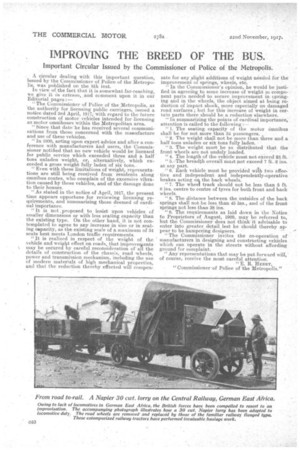IMPROVING THE BREED OF THE BUS.
Page 16

If you've noticed an error in this article please click here to report it so we can fix it.
Important Circular Issued by the Commissioner of Police of the Metropolis.
. A circular dealing with this important question, issued by the Conunissioner of Police of the Metropolis, was published on the 8.th inst.
In view of the fact that it is somewhat far-reaching, we give it in extenso, and comment upon it in our Editorial pages
"The Commissioner of Police of the Metropolis, as the authority for licensing public carriages, issued a notice dated 3rd April, 1917, with regard to the future construction of motor vehicles intended for -licensing as motor omnibuses within the Metropolitan area. "Since that date he has received several communications from those concerned with the manufacture and use of these vehicles.
"in 1909, acting upon expert advice and after a conference with manufacturers And users, the Commissioner notified that no new vehicle would be licensed for public service which exceeded three and a half tons unladen weight, or alternatively, which exceeded a gross weight fully laden of six tons. "Even with these limitations of weight, representations are still being received from residents along omnibus routes, who complain of the excessive vibration caused by these vehicles, and of the damage done to their houses.
"As stated in the notice of April, 1917, the present time appears opportune for reviewing licensing requirements, and summarizing those deemed of cardinal importance.
"It is not , proposed to insist upon vehicles of smaller dimensions or with less seating capacity than the existing type. On the other hand, it is not contemplated to agree to any increase in size or in seating capacity, as the existing scale of a maximum of 34 seats best meets London traffic requirements.
"It is realized in respect of the weight of the vehicle and weight effect on roads, that improverpents may be secured by careful reconsideration of all the details of construction of the chassis, road 'wheels, power and transmission mechanism, including the use of modern materials of high mechanical properties, and that the reduction thereby effected will compen
sate for any slight additions of weight needed for the improvement of springs, wheels, etc.
"In the Commissioner's opinion, he would be justified in agreeing to some increase of weight in component parts needed to secure improvement in springing and in the wheels, the object aimed at being reduction of impact shock, more especially on damaged road surfaces ; but for this increase of weight in certain parts there should be a reduction elsewhere.
'In summarizing the points of cardinal importance, attention is called to the following :-- " 1. The seating capacity of the motor Omnibus shall be for not more than 34 passengers. ,
"2. The weight shall not be more than three and a half tons unladen or six tons fully laden.
"3. The weight must be so distributed that the front wheels are not unduly loaded. "4. The length of the vehicle must not exceed 23. ft. . " 5. The breac4h overall Must not exceed 7 ft. 2 ins. at any part. "6. Each vehicle must be provided with two effective and independent and independently-operative brakes acting ori the back wheels.
"7. The wheel track should not be less than 5 ft. 6 ins, centre to centre of tyres for both front and back wheels.
"8. The distance between the outsides of the back springs shall not be less than 45 ins., and of the front springs not less than 38 ins.
"9. The requirements as laid down in the Notice to Proprietors of August, 1909, may be referred to, but the Commissioner does not think'it advisable to enter into greater detail, lest he should thereby appear to be hampering designers. "The Commissioner invites the co-operation of manufacturers in designing and constructing vehicles which can operate in the streets without affording ground for complaint.
"Any representations that may be put forward will," of course, receive the most careful attention.
"E. R. HENRY, "Commissioner of Police of 'the Metropolis."


























